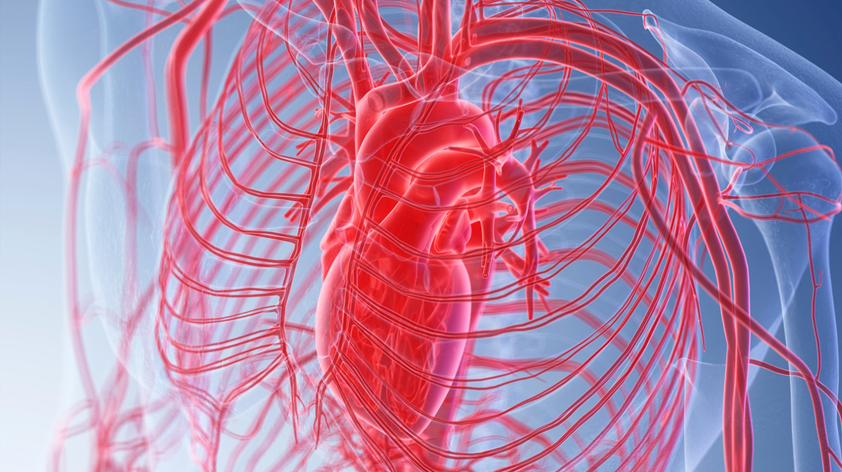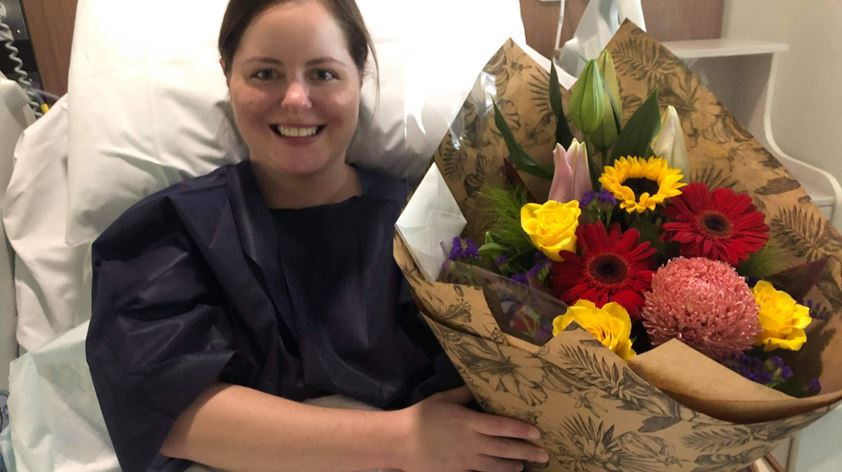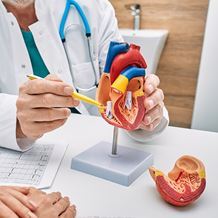Detection of congenital heart disease is on the rise
St Vincent's Private Hospital Northside
It’s the surprisingly common hidden disease that can sneak up on people at any age - from prenatal, aged up to their seventies - with potentially deadly consequences.
The unwelcome news is that the number of Australians being detected with congenital heart disease (CHD) is rising every year. The good news is that people detected with CHD are generally living longer than they would have 20-30 years ago.
More than 65,000 people - roughly a city the size of Rockhampton (Queensland) - are living with congenital heart disease in Australia. Although each year, upwards of a thousand new patients are discovered to have the disease, when it might have previously gone undiagnosed for many, many years.
Congenital heart disease is a general term for any defect of the heart, heart valves or central blood vessels that is present at birth. Most congenital heart disease arises through combinations of genetic and environmental factors.

Leading St Vincent’s Private Hospital Northside interventional cardiologist Professor Darren Walters says improved diagnostic technologies such as imaging and scans, means that previously undetected CHD - which sometimes might not have caused significant health issues throughout people’s lives - are now able to be diagnosed (often later in life).
The congenital disease can become more prominent as people age, especially if a patient’s health starts to deteriorate for a variety of reasons.
“There is a growing burden within the health system of people who aren’t detected until they are adults, who might have been born with a congenital heart disease but they never knew it until recent years. And in some cases, they still might be diagnosed and might not be aware of it,” says Professor Walters.
“They might have experienced symptoms such as shortness of breath, chest pain or arrhythmia (an abnormal heartbeat) or noticed other warning signs such as heart palpitations and even swelling of the ankles.
“Thirty years ago people born and diagnosed with congenital heart disease would have had surgery when they were very young which in some cases could have been open heart surgery. However in many cases, especially if it was undetected, they might have even survived into adulthood.
“At best it might not have impacted on their quality of life and might not have been detected by their GP. But at worst some cardiac conditions - if undetected - could cause a major cardiac event or even premature death.
“The two most common forms of congenital heart disease in adults are bicuspid aortic valve and atrial septic defect, better known as a ‘hole in the heart’. A bicuspid aortic valve is when a person has two, instead of the normal three flaps or cusps. The aortic valve is between the left lower heart chamber and the aorta, the body's main artery. Flaps of tissue on the valve open and close with each heartbeat which ensures blood flows in the correct direction.”

Professor Walters says that having a bicuspid aortic valve raises the risk of valve problems arising later in life. In some patients, the disease can make it harder for the heart to pump out enough blood to meet the body’s demands and they may require surgery to improve the function of the aortic valve.
Professor Walters says that medical innovations allowing for minimally invasive procedures using a trans catheter approach have been a game-changer, and life-changer for thousands of patients.
“This type of interventional procedure has become much safer, the efficacy is higher and patients make a more rapid recovery. We often find they are discharged within a day or two and they can return to work within days. It is possible to resume physical activity such as running, swimming and going to the gym,” says Professor Walters.
He says if anyone has any sort of family history of congenital heart disease or if they start to experience new symptoms such as shortness of breath, chest pain, abnormal heartbeat, heart palpitations or unusual ankle swelling they should consult their GP and seek a referral to a cardiologist.
“At best it might not have impacted on their quality of life and might not have been detected by their GP. But at worst some cardiac conditions - if undetected - could cause a major cardiac event or even premature death."

From blue babies, to open heart surgery and onto the long run of life
Meet two St Vincent’s patients with congenital heart disease who have recently had lifesaving surgery by leading heart specialist Professor Darren Walters.
Nicky Till from Cairns and Ricky Salusbury from the Gold Coast have never met – but they share an uncommon trait and similar medical histories. They were both born ‘blue babies’ due to congenital heart disease and both had open heart surgery by the time they were 16!
They have both also recently had further lifesaving surgery from St Vincent’s Private Hospital Northside interventional cardiologist Professor Darren Walters allowing Nicky and Ricky to both enjoy better health and a quality of life that they hadn’t known for years.
Nicky was born with pulmonary stenosis, a narrowing of the pulmonary valve which can happen when the pulmonary valve doesn’t grow as it should in a baby in the first eight weeks of pregnancy (the pulmonary valve connects the right ventricle to the pulmonary artery and normally has three flaps or leaflets that work like a one-way door).
The most obvious symptom was that she was born with a blue-purple colour around the lips and fingers which was a sign of low oxygen levels caused by the defective valve (this can happen when the pulmonary valve doesn't grow as it should in a baby during the first eight weeks of pregnancy.)
Doctors tested her with an echocardiogram at six weeks and opted to delay surgery until she was 12 months old when they performed a balloon valvuloplasty procedure which was designed to widen the valve. Nicky says the fact that as a one-year old baby she needed heart surgery “was pretty scary for my parents.”
“But that surgery helped me live a fairly normal and active childhood and through into my early teen years, including playing sports like hockey, water skiing as well as dancing! However when I was 16, as expected, I needed open heart surgery to replace the pulmonary valve with a pig’s valve and to repair the tricuspid valve,” says Nicky.
“I always knew that wouldn’t last forever but I was surprised when in 2021 when I was aged 30 and I started to struggle with breathlessness and fatigue – even though I was fit and going to the gym regularly and doing F45 classes which are pretty intense.
“I knew something was wrong and after a period where I couldn’t get a clear diagnosis, doctors worked out that I had a complete blockage in one of my valves and I had a pacemaker inserted.”
Nicky said her doctors had told her that she would always need another valve replacement with the life span of the implant being 5-10 years - and that finally happened under the expert guidance of Professor Darren Walters at St Vincent’s Private Hospital in February 2024 where he replaced the pig’s valve with a cow’s valve.
Thankfully she was able to avoid open heart surgery with Professor Walters performing the minimally invasive surgery by doing a trans catheter pulmonary valve implantation, inserting the new valve through her groin. The benefit of that procedure was that her recovery period was around one week compared to 8-12 weeks if she had open heart surgery.
Just over two months since she had that surgery and Nicky - who works as a dental assistant for Queensland Health based in Cairns and also travelling to other Far North Queensland communities – says she has made a great recovery.
“I’m not a runner but I managed to run 1km non-stop recently which was fantastic so soon after surgery and my goal now is to be able to run 5km and maybe do a local Park Run in the next few months. I can’t thank Professor Walters and the amazing team at St Vincent’s enough for taking great care of me,” says Nicky.
Forty three year old cabinet maker Ricky also had a similar start to life as Nicky, also displaying similar early symptoms with blue-purple coloured lips and fingers. His was also caused by a rare congenital heart condition – but he was diagnosed with Tetrology of Fallot - a combination of congenital defects consisting of three key features: pulmonary stenosis, atrial septal defect and right ventricular hypertrophy.
Ricky required open heart surgery when he was just 18 months which enabled him to live out a fairly normal childhood playing a variety of sports, including soccer, cricket and running, although contact sports such as rugby were off limits.
“I was always a small child but despite my size and heart condition, that didn’t stop me from being really active which I was very thankful for and then I had a growth spurt at 16. We established that there was probably some family history of congenital heart disease on my Dad’s side but it’s not clear exactly what that was,” says Ricky.
Ricky, like Nicky, required a pulmonary valve replacement with human tissue in his mid-teens (when aged 15) which also involved open heart surgery, which was successfully done at Prince Charles Hospital.
He was told the valve would probably need replacing again by the time he was 30, but he was luckily able to live a healthy normal life until he turned 40 – that included competitive middle distance running with an amazing personal best over the 5km distance of 18 minutes 45 seconds in a local fun run.
“I felt very lucky firstly to be able to be healthy through my childhood and teen years and able to train hard and run competitively. I always pushed myself pretty hard with sport, although I always felt as if I could have run faster and couldn’t push myself to my full physical limit as my heart just wouldn’t allow me to go absolutely flat out,” says Ricky.
In early 2022, having researched and enquired around leading interventional cardiologists, Ricky made an appointment with St Vincent’s Professor Walters who opted to do surgery in August of that year to replace his animal heart tissue valve with a synthetic valve. He performed the minimally invasive trans catheter pulmonary valve implantation inserting the new valve through her groin.
“The surgery took a bit longer than expected but was over in around four hours and my recovery since then has been fantastic. I feel awesome and I’m even more health-conscious than I ever was before with my diet and exercise,” says Ricky.
“Although I have to take blood thinners and being a cabinet-maker and having my own business means that I often have little incidents where I cut or nick myself and I start bleeding a fair bit so I just always carry a few Band-Aids around with me.”
He’s also thankful for the fact that he’s now a father and tests have shown no sign of congenital heart disease in his two young children.
- Home
- Patient News
- Detection of congenital heart disease is on the rise




